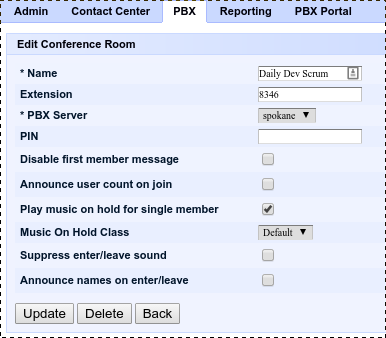The common conference room, a necessity in today’s world with employees working from home, travelling, and distant customers. No product with PBX functionalities should be without one.
Lets take a look at the options for the conference rooms provided by the Q-Suite.

The options seen are:
- Name – a Friendly name. If the room is used for a purpose, as our example is, then it’s best to name it after that. This will be the name seen elsewhere within the system.
- Extension – the extension used for directly dialing it from an extension.
- PBX Server – This is hidden if your system has a single PBX server. In the case where there is multiple this can be used to distribute load or in the case of a geo-diverse system ensure the conference is on the server closest to the majority of participants to ensure quality and limit bandwidth usage.
- PIN – a numeric pin to secure the conference with.
- Disable first member message – If checked this will not playback a message stating the first member is the only one in the conference.
- Announce user count on join – If checked this will announce to the user how many users are already in the conference they are joining.
- Play music on hold for single member – If checked this will play music on hold when the conference has a single user. Otherwise the user will only hear silence.
- Music On Hold Class – what music on hold to play when it’s a single user conference and the above is checked.
- Suppress enter/leave sound – If checked a user joining or leaving the conference will not trigger the tones to be played to all conference members.
- Announce names on enter/leave – If checked each user joining will be prompted to record their name before they join. This recording will be used as the join or leave
With all of these options you can configure the conference rooms you needed. However to fully leverage conference rooms, or any single feature, the ability to combine and interlink them to suit your needs is required. Let’s take the example of a daily standup which needs a conference room for a few remote employees. It’s always starts at 8am and lasts about 30 minutes. One way to ensure outside callers do not use it outside of this hours is a pin but you can also mix it with the Routing Rules so the DID or IVR/Auto Attendant option is not configured to point directly to the conference room but to a routing rule first. This routing rule will only route callers there at 8am until 8:30, although I’d recommend 15 mins earlier at least to allow early callers in and maybe a bit longer depending if the meeting has a strict end time or not. The routing rule can then send them to an auto attendant or elsewhere in the system if it’s outside of the hours — add multiple rules to allow different routing if it’s before to note they are to early, or if they are late to send them to a recording of the conference to hear what they missed.










